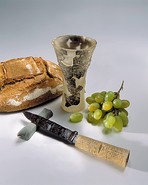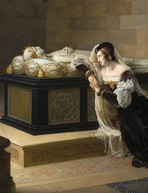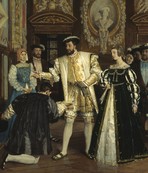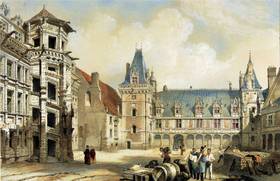- Home >
- Royal chateau of Blois >
- History and architecture >
- The historic periods
The historic periods
Numerous major events in the history of France took place in the royal castle of Blois. Many illustrious figures were born or resided in its confines: counts of Blois, dukes of Orleans, kings of France... The chateau is a site of memory bringing to mind not only the political and religious history of our country, but also culture and the history of the arts.
The county of Blois (5th - 14th century)

 The most celebrated history of the county involves the dynasty founded by Thibaud I. His descendants, Eudes I (?-996) and Eudes II (?-1037), had as foes the Capetian kings and the counts of Anjou who controlled Touraine, but they managed to acquire Champagne in 1023, thereby extending the boundaries of the royal domain. Count Etienne-Henry (1047-1102) was one of the leaders of the 1st crusade and participated first in the takeover of Nicaea and then in the siege of Antioch (1097). In 1125 Theobald IV the Great (1093-1151) reunified Champagne and Blois; at that point in time, he was the second most important figure of the kingdom. After Thibaud VI, the county of Blois passed into the hands of the house of Chatillon-sur-Seine, which exerted considerably less political influence.
The most celebrated history of the county involves the dynasty founded by Thibaud I. His descendants, Eudes I (?-996) and Eudes II (?-1037), had as foes the Capetian kings and the counts of Anjou who controlled Touraine, but they managed to acquire Champagne in 1023, thereby extending the boundaries of the royal domain. Count Etienne-Henry (1047-1102) was one of the leaders of the 1st crusade and participated first in the takeover of Nicaea and then in the siege of Antioch (1097). In 1125 Theobald IV the Great (1093-1151) reunified Champagne and Blois; at that point in time, he was the second most important figure of the kingdom. After Thibaud VI, the county of Blois passed into the hands of the house of Chatillon-sur-Seine, which exerted considerably less political influence.
The duchy of Orleans (1397 - 1498)

 In 1397, Louis I of Orléans acquired the county of Blois. Due to his influence over King Charles VI, the Duke of Burgundy had him assassinated in 1407. The following year his widow, Valentine Visconti, also died. After 1415, when Duke Charles was being held captive, his half-brother Jean, « the Bastard of Orleans », presided over the duchy and negotiated his release. The son of Duke Charles, Louis II, led the feudal opposition and rebelled against the authority of King Charles VIII. Following the « Mad War » (1488), in which he was defeated, Louis finally got back into the good graces of Charles, with whom he was allied in Italy in 1494. Once the king had died, Louis II succeeded him and the county of Blois became part of the royal domain.
In 1397, Louis I of Orléans acquired the county of Blois. Due to his influence over King Charles VI, the Duke of Burgundy had him assassinated in 1407. The following year his widow, Valentine Visconti, also died. After 1415, when Duke Charles was being held captive, his half-brother Jean, « the Bastard of Orleans », presided over the duchy and negotiated his release. The son of Duke Charles, Louis II, led the feudal opposition and rebelled against the authority of King Charles VIII. Following the « Mad War » (1488), in which he was defeated, Louis finally got back into the good graces of Charles, with whom he was allied in Italy in 1494. Once the king had died, Louis II succeeded him and the county of Blois became part of the royal domain.
The wars of Italy (1492 - 1559)

 Numerous military operations were conducted by the kings of France as they attempted to conquer the kingdom of Naples and the duchy of Milan. In 1492, when Charles VIII set out to conquer Naples, the stakes quickly grew higher: Who would exercise hegemony in Europe? Fragmented into numerous distinct political entities, Italy was wealthy, densely populated ... and highly coveted by foreigners. The Habsburg and the Valois houses were perennial rivals there, but following the defeats of François I and of Henri II, Spain gained the upper hand over the Apennine Peninsula. The conflicts finally came to an end in 1559 with the treaties of Cateau-Cambrésis, through which France relinquished its remaining claims on Italy.
Numerous military operations were conducted by the kings of France as they attempted to conquer the kingdom of Naples and the duchy of Milan. In 1492, when Charles VIII set out to conquer Naples, the stakes quickly grew higher: Who would exercise hegemony in Europe? Fragmented into numerous distinct political entities, Italy was wealthy, densely populated ... and highly coveted by foreigners. The Habsburg and the Valois houses were perennial rivals there, but following the defeats of François I and of Henri II, Spain gained the upper hand over the Apennine Peninsula. The conflicts finally came to an end in 1559 with the treaties of Cateau-Cambrésis, through which France relinquished its remaining claims on Italy.
The royal sojourns (1498 - 1589)

 Starting in 1498, the kings' sojourns in Blois were punctuated by political visits and different festivities, such as the wedding of Cesare Borgia (1499) and the engagement of Marguerite of Angoulême. Blois was where Louis XII received the archduke of Austria (1501) and Machiavelli (1510). Balls, concerts and theatrical productions showcased the splendor of the Valois court. In 1547, Henri II entered Blois accompanied by naked women mounted on oxen reminiscent of the myth of Princess Europe, and organized a grand tournament. At the same time, the royal castle of Blois was one of the places from which the king administered the kingdom and convened the Estates General.
Starting in 1498, the kings' sojourns in Blois were punctuated by political visits and different festivities, such as the wedding of Cesare Borgia (1499) and the engagement of Marguerite of Angoulême. Blois was where Louis XII received the archduke of Austria (1501) and Machiavelli (1510). Balls, concerts and theatrical productions showcased the splendor of the Valois court. In 1547, Henri II entered Blois accompanied by naked women mounted on oxen reminiscent of the myth of Princess Europe, and organized a grand tournament. At the same time, the royal castle of Blois was one of the places from which the king administered the kingdom and convened the Estates General.
The French Renaissance (16th century)

 During the 16th century, renewed thought was based on the rediscovery of the antique Italian monuments and the literature of Greco-Roman antiquity. Princes returned from Italy with works of art and artists who contributed to the evolution of French artistic creation. In 1517 François I welcomed Leonardo da Vinci to Amboise; he was also the benefactor of other Italian artists; in 1530, Rosso Firoentino and Primaticcio worked in Fontainebleau. The French monarch's collection brought together works of Michelangelo, Raphael and Titian; as « father of Letters » François created the royal library in Blois; in 1544, he had it transferred to Fontainebleau.
During the 16th century, renewed thought was based on the rediscovery of the antique Italian monuments and the literature of Greco-Roman antiquity. Princes returned from Italy with works of art and artists who contributed to the evolution of French artistic creation. In 1517 François I welcomed Leonardo da Vinci to Amboise; he was also the benefactor of other Italian artists; in 1530, Rosso Firoentino and Primaticcio worked in Fontainebleau. The French monarch's collection brought together works of Michelangelo, Raphael and Titian; as « father of Letters » François created the royal library in Blois; in 1544, he had it transferred to Fontainebleau.
The wars of religion (1562-1598)

 In 16th-century France, a series of eight conflicts pitted Protestants against Catholics. Persecution of participants in the Reformation started as early as the 1520s, but only towards the end of the reign of Henri II did the cleavages become severe. The conflict having been politicized, wars got underway in 1562 and were pursued on and off until 1598, when the Edict of Nantes was promulgated. The persecutions nonetheless continued through the 17th and the 18th centuries (siege of La Rochelle, revocation of the Edict of Nantes), up until the Versailles edict of 1787.
In 16th-century France, a series of eight conflicts pitted Protestants against Catholics. Persecution of participants in the Reformation started as early as the 1520s, but only towards the end of the reign of Henri II did the cleavages become severe. The conflict having been politicized, wars got underway in 1562 and were pursued on and off until 1598, when the Edict of Nantes was promulgated. The persecutions nonetheless continued through the 17th and the 18th centuries (siege of La Rochelle, revocation of the Edict of Nantes), up until the Versailles edict of 1787.
The military barracks (1788 - 1867)

 During the 18th century, the castle slowly deteriorated and buildings were torn down. Maintenance had become too costly. In 1788, Louis XVI put it up for sale, but there were no buyers, and the « Comtois » royal regiment set up their quarters on the premises. While the military men's work caused further deterioration, they concomitantly maintained the castle and pursued renovation of the classical wing. In 1810 the buildings reverted to the town of Blois, but they were still occupied by the army. The François I wing was restored in 1845 so that a museum could be installed, but it was only in 1867 that the royal castle of Blois was returned in full to civil administration.
During the 18th century, the castle slowly deteriorated and buildings were torn down. Maintenance had become too costly. In 1788, Louis XVI put it up for sale, but there were no buyers, and the « Comtois » royal regiment set up their quarters on the premises. While the military men's work caused further deterioration, they concomitantly maintained the castle and pursued renovation of the classical wing. In 1810 the buildings reverted to the town of Blois, but they were still occupied by the army. The François I wing was restored in 1845 so that a museum could be installed, but it was only in 1867 that the royal castle of Blois was returned in full to civil administration.
Restoration of the chateau (1845 to the present)
 In 1843 Felix Duban presented Prosper Mérimée with a project aimed at restoring the royal castle of Blois on the basis of vestiges and designs dating back to 1572. Two years later, it was the first historical monument outside of Paris to be restored by the French state, and it served as a model for the restoration of other castles. At the outset of the 20th century, several phases of rehabilitation took place one after another; one of the major achievements consisted in restoration of the grand staircase of the Gaston of Orleans wing. An exceptional restoration program undertaken in the 1990s and the 2000s once again involved the roofing, the facades and the flooring of the François I wing as well as the polychrome painted decorations; so it is that the castle has recovered its 19th-century colors.
In 1843 Felix Duban presented Prosper Mérimée with a project aimed at restoring the royal castle of Blois on the basis of vestiges and designs dating back to 1572. Two years later, it was the first historical monument outside of Paris to be restored by the French state, and it served as a model for the restoration of other castles. At the outset of the 20th century, several phases of rehabilitation took place one after another; one of the major achievements consisted in restoration of the grand staircase of the Gaston of Orleans wing. An exceptional restoration program undertaken in the 1990s and the 2000s once again involved the roofing, the facades and the flooring of the François I wing as well as the polychrome painted decorations; so it is that the castle has recovered its 19th-century colors.
Dive into the universe of 3D screens!
January, 12 : exceptional closure of the castle









